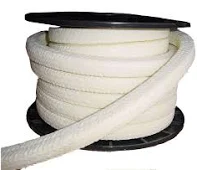PTFE packing offers several significant advantages that make it a preferred choice in many industrial applications. These benefits stem from the inherent properties of PTFE as a material, which include its chemical resistance, temperature stability, low friction coefficient, and overall versatility. Below, we will explore these key advantages in detail.

Chemical Resistance
One of the most notable advantages of PTFE packing is its exceptional chemical resistance. PTFE is nearly inert, meaning it does not react with most chemicals, acids, or solvents. This makes PTFE packing ideal for use in harsh chemical environments where other materials would degrade or fail.
Whether used in pumps, valves, or other equipment, PTFE packing can withstand prolonged exposure to aggressive chemicals without breaking down or losing its sealing properties. This chemical resistance ensures the integrity of the seal and reduces the frequency of maintenance, contributing to lower operational costs and increased equipment reliability.
Temperature Stability
PTFE packing is known for its remarkable temperature stability, performing well across a wide temperature range. PTFE can endure extreme cold and heat, from cryogenic temperatures to temperatures exceeding 250°C (482°F), without losing its structural integrity.
This temperature stability makes PTFE packing suitable for applications where other materials might fail due to thermal expansion, contraction, or degradation. Industries that operate in extreme environments, such as aerospace, chemical processing, and power generation, particularly benefit from the reliable performance of PTFE packing in fluctuating or high-temperature conditions.

Low Friction Coefficient
Another key advantage of PTFE packing is its very low coefficient of friction. PTFE’s non-stick properties reduce friction between the packing and the moving parts of the equipment, such as valve stems, shafts, and pistons.
This low friction minimizes wear on both the packing and the equipment, leading to longer service life and reduced maintenance needs. Additionally, lower friction means less energy is required to operate the equipment, contributing to improved efficiency and lower energy costs. This characteristic is particularly beneficial in dynamic applications where continuous movement could otherwise lead to rapid wear and tear.
Versatility Across Industries
The versatility of PTFE packing is unmatched, making it a go-to solution across a wide range of industries. From chemical processing and pharmaceuticals to food production, power generation, and aerospace, PTFE packing is used in various applications due to its adaptability to different environments and operational demands.
For example, in the chemical industry, PTFE packing is chosen for its resistance to corrosive substances, while in the food industry, it is preferred for its non-reactive and non-contaminating properties. This versatility ensures that PTFE packing can meet the stringent requirements of diverse industrial sectors, making it an essential component in many critical processes.


